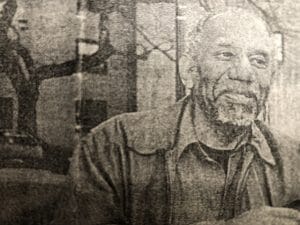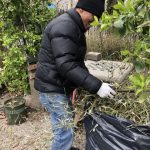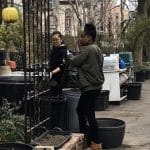From NYT: SCIENTIST AT WORK – Felton Earls; Theory Analyzes Crime As Science, Neighbor by Neighbor
by Dan Hurley 2004
photo by Rick Friedman NYT
“Dr. Felton Earls was on the street, looking for something at ground level that would help explain his theories about the roots of crime. He found it across from a South Side housing project, in a community garden of frost-wilted kale and tomatoes…
”Please respect our efforts”
…Dr. Earls and his colleagues argue that the most important influence on a neighborhood’s crime rate is neighbors’ willingness to act, when needed, for one another’s benefit, and particularly for the benefit of one another’s children. And they present compelling evidence to back up their argument.
…His research is, in essence, about the health of communities, not just about crime. ”I am concerned about crime,” he said, ”but my background is in public health. We look at kids growing up in neighborhoods across a much wider range than just crime: drug use, school performance, birth weights, asthma, sexual behavior.”
His study…challenged an immensely popular…theory about the roots of crime. ”Broken windows,” as it is known, holds that physical and social disorder in a neighborhood lead to increased crime, that if one broken window or aggressive squeegee man is allowed to remain in a neighborhood, bigger acts of disorderly behavior will follow…
In a landmark 1997 paper that he wrote with colleagues in the journal Science, and in a subsequent study in The American Journal of Sociology, Dr. Earls reported that most major crimes were linked …to two.. neighborhood variables: concentrated poverty and … collective efficacy.
…The point of intervention is not to clean up the neighborhood, but to work on its collective efficacy. If you organized a community meeting in a local church or school, it’s a chance for people to meet and solve problems.
”If one of the ideas that comes out of the meeting is for them to clean up the graffiti in the neighborhood, the benefit will be much longer lasting, and will probably impact the development of kids in that area. But it would be based on this community action — not on a work crew coming in from the outside.”
…As for policy implications, Dr. Earls said that rather than focusing on arresting squeegee men and graffiti scrawlers, local governments should support the development of cooperative efforts in low-income neighborhoods by encouraging neighbors to meet and work together. Indeed, cities that sow community gardens, he said, may reap a harvest of not only kale and tomatoes, but safer neighborhoods and healthier children.”
“Research shows that in a city of 100,000, each new nonprofit community organization lead to a 1.2 percent drop in the homicide rate, a 1 percent reduction in the violent crime rate, and a 0.7 percent reduction in the property crime rate.”…
….Federal legislation such as the Reverse Mass Incarceration Act would provide resources to states to pursue creative approaches to helping communities bring down crime, while bills like the Sentencing Reform and Corrections Act would help fix our misguided use of overly-harsh punishments to reduce crime. While more research is needed to improve our public response to crime, supporting the community organizations that helped drive the crime decline is an excellent place to start.” Read more here.




